AMD Radeon RX 5700 and 5700 XT review: Blazing new trails - donahuewholoney

At a Glance
Expert's Valuation
Pros
- Best-in-class power efficiency
- Fantabulous gambling performance
- New RDNA architecture improves performance in several games
- First PCIe 4.0 GPU
- Ready for 4K, 120Hz HDR monitors without chroma subsampling
- Much better memory configuration than RTX 2060
Cons
- No holy ray tracing hardware
Our Verdict
The Radeon RX 5700 delivers excellent gambling carrying out and mogul efficiency while flowing the goal posts forward on various technological fronts.
Best Prices Today

Not Available
The Radeon RX 5700 and Radeon RX 5700 XT graphics cards represent a clean slate and a bright subsequent for AMD, brimming with technologies that have never been seen in GPUs before.
The Radeon RX 5700 series are the first mainstream GPUs reinforced victimisation the bleeding-sharpness 7nm manufacturing process (hence their July 7 set up). They're the opening graphics cards packing the ultra-fast PCIe 4.0 interface. They're the first graphics cards crafted with AMD's all-new "RDNA" architecture, which delivers a massive power efficiency rise that Radeon's been needing for years. They're packing fresh expose technologies to enable 4K, 144Hz monitors without the need for messy vividness subsampling. They've upgraded to GDDR6 memory. Heck, AMD even managed to domesticise their cetacean-dash cooler design, learning from the mistakes of the frankly unpleasant-to-be-around Vega 64.
Nvidia tried and true to spoil their set up with the surprise discharge of the excellent GeForce RTX 2060 Super and RTX 2070 Super, but some aggressive pre-launch cost cuts by AMD foiled that plan. The $350 Radeon RX 5700 and $400 Radeon RX 5700 XT are great graphics cards, grumbling stop.
Radeon RX 5700 and 5700 Crosstalk: Specs and features
Warning: With so much newborn applied science baked into the Radeon RX 5700 serial publication, this is going to be a long review. We'atomic number 75 leaving to kick it off aside talk or so what's fresh under the punk. Feel free to use the table of contents at left to hop between sections if you'd like. Got it? Good. On to the sang-froid stuff.
Let's kick things off by examining the computer hardware, before delving into about spick-and-span computer software features later. Here's an AMD-supplied list of study specifications for the Radeon RX 5700 and Radeon RX 5700 XT, aboard the same stats for the Radeon RX Lope de Vega GPUs they're replacing in AMD's product stack. (Radeon gaffer Scott Herkelman inveterate that Vega will be vanishing in The Full Nerd interview embedded above.)
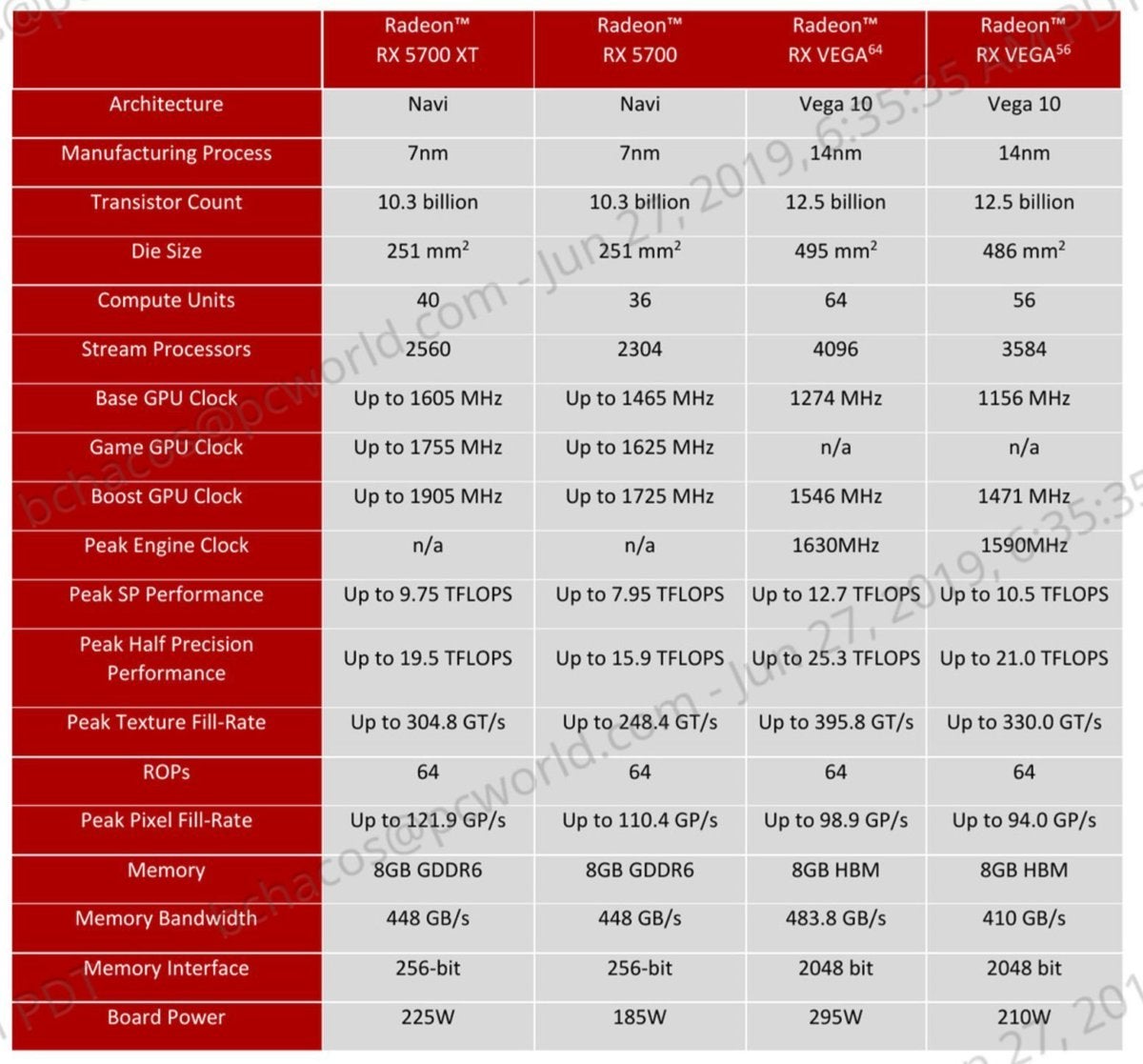 AMD
AMD While that table provides a helpful overview, greenbac that you cannon simply compare the number of calculate units and pelt processors betwixt the Lope de Vega GPUs and the "Navi" GPUs in the Radeon RX 5700 serial publication. Compared to AMD's durable GCN computer architecture (which Vega is based happening), the parvenu RDNA architecture introduces several radical changes to the underlying GPU figure, unleashing significant ironware-level overhauls to everything from the cache to the graphics engine to the compute units themselves. These new graphics cards perform tasks other than from their predecessors at a fundamental level.
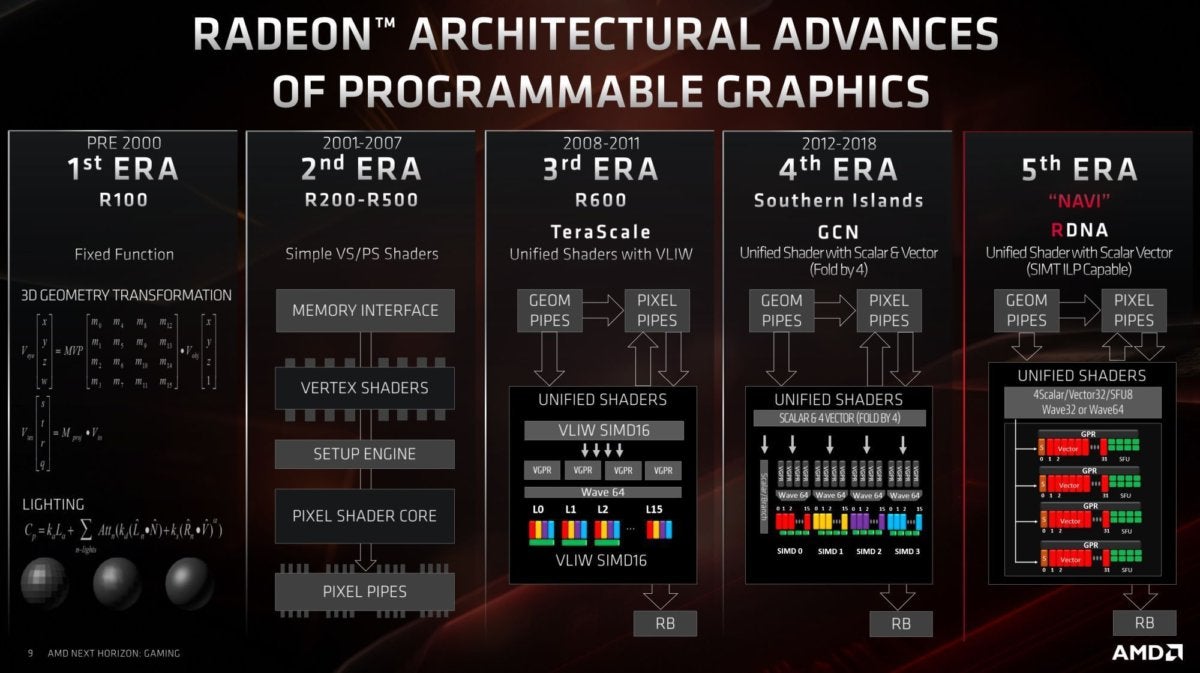 AMD
AMD We're not going to get into the widow's weeds of redesigned cache hierarchies and SIMD Wave cycles Hera. If you neediness an insightful yet understandable explanation of the major RDNA computer architecture changes and have 23 minutes to meagerly, I highly recommend watching the Gamers Nexus interview with technology analyst David Kanter embedded below. It's great.
AMD says that betwixt the RDNA tweaks and the shift to the 7nm manufacturing process, its hot cards are a good deal more powerful and power-efficient than before—claims that bear fruit in our testing. (Spoiler alert: Navi is eventide more power-efficient than Nvidia's Turing architecture, a monumental reversal of the average with GCN.)
The caller's architecture deep-dive for reporters touted some awing numbers for Navi: 25 percent Thomas More performance per clock versus Vega, and a large 50-percent performance increase whole at the duplicate power levels. Impressive. Those performance-per-clock improvements also make the TFLOPS comparisons in the graph above misleading, as these Navi GPUs bash more with each teraflop.
Speaking of Erodium cicutarium, the Radeon RX 5700 and 5700 XT collide with much, much higher clock speeds than AMD's previous cards, surpassing Vega's best by hundreds of megahertz. No matter how you measure it, that's a dear matter. AMD also introduced new time speed nomenclature to more clearly express estimated carrying into action levels.
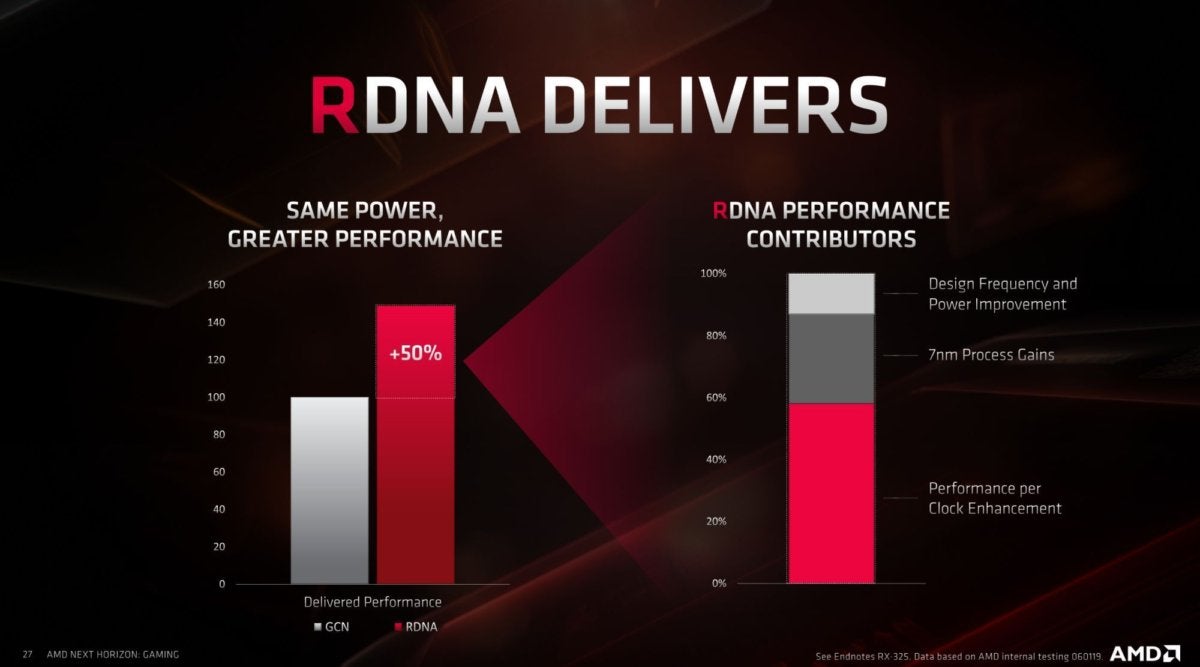 AMD
AMD The company's providing three time speeds for Navi GPUs: Base and boost are what you'd expect, defining the upper and lower limits. But AMD's also listing a "halting time," that represents "the minimum expected GPU clock when running gaming applications." It warns that those speeds aren't warranted or fifty-fifty kick in the VBIOS, just is rather simply "a guide used to fructify expectations with gamers." Nvidia handles its catalogued Boost clocks in the same manner, so if you privation to compare GeForce card game against the Radeon RX 5700's speeds, look there.
Note that it says "nominal expected GPU clock," and that they were obtained using AMD's blower-style reference card game. In the Full Nerd interview at the crowning of this article, Radeon boss Scott Herkelman acknowledged that overclocked, custom-cooled models by AMD partners could alright push gaming speeds nearer to the Boost time rating, A you'd gestate.
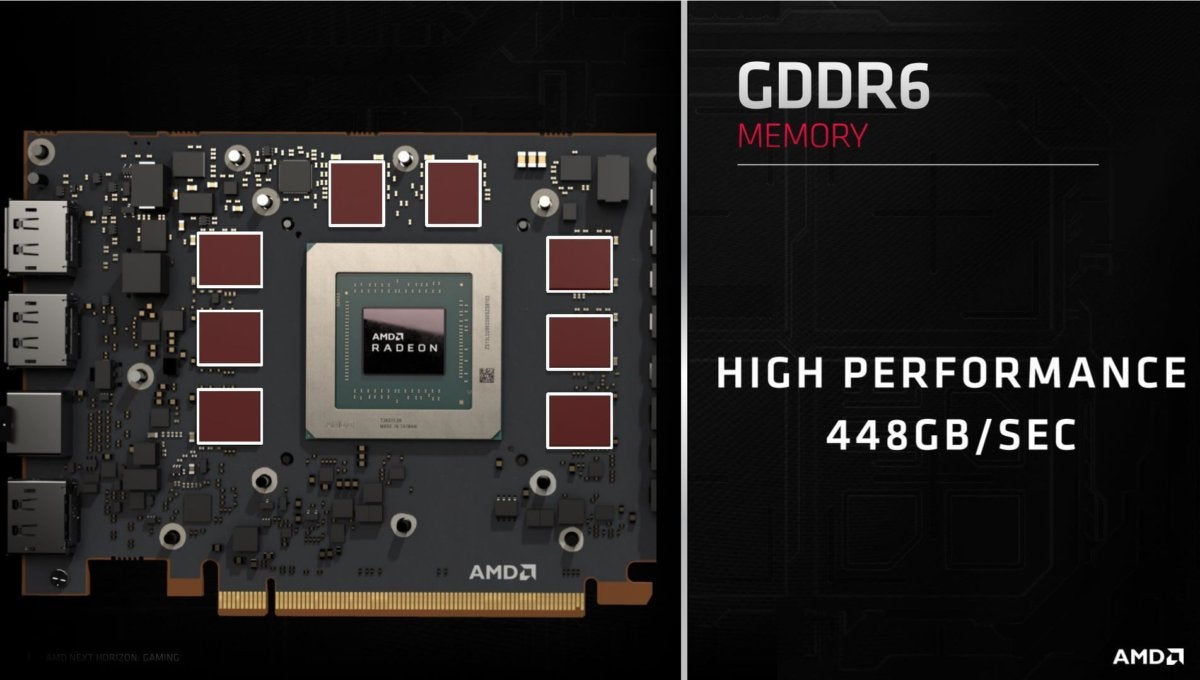 AMD
AMD The Radeon RX 5700 and RX 5700 XT also change the underlying memory configuration. The Radeon VII and Vega GPUs utilized second-generation soaring-bandwidth retentiveness stacks, continuing the HBM push that AMD spearheaded with the Fury X in 2015. AMD switched to traditional GDDR6 memory for these new card game, matching Nvidia's current GeForce lineup.
For Nvidia, the switch from GDDR5 to GDDR6 provided enormous throughput benefit thanks to GDDR6's much quicker speeds. It's more of a lateral move performance-wise for AMD, because HBM2's 2,048-bit all-embracing storage interface allowed for superior memory bandwidth speeds. The Navi cards we're reviewing today hit 448GB/second of memory bandwidth thanks to their 8GB capacity and 256-bit bus.
"We are not ruling out HBM2 in our roadmap," Herkelman told me in our Full Swot interview. "We will continue to support that in markets that make sense." For these Radeon RX 5700 cards in primary, GDDR6 lets AMD "remov better terms points [and] still get great execution" while beingness more widely adopted than HBM2, whose pricing he called "fickle." The major power-supperless Vega cards needed HBM2's energy efficiency, only AMD says GDDR6 offers 60-percent-improved performance per W versus GDDR5.
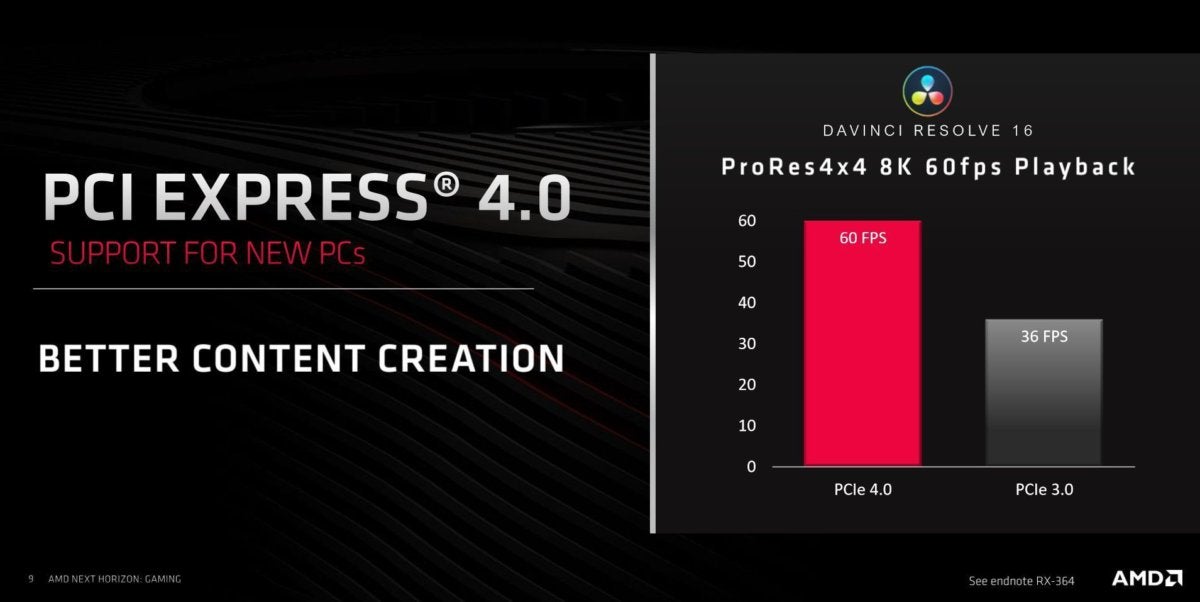 AMD
AMD Quicker, Sir Thomas More efficient clocks and quicker, more efficient memory both provide tangible benefits to PC gamers. One of the flagship features of the Radeon RX 5700 serial, PCIe 4.0 support, doesn't—leastways in rule gaming scenarios. Bodoni font graphics cards simply don't impregnate the PCIe 3.0 x16 interface typically used in about gaming PCs. I'd wondered whether the travel to PCIe 4.0 could benefit execution in CrossFire setups, because those need to tap into a narrower x8 connection. Herkelman aforesaid any benefits would be "nook case, game-dependent, and situational." He said He wouldn't recommend citizenry buy out into PCIe 4.0 right for potential improvements to multi-GPU gaming.
Update:The Radeon RX 5700 serial publication only supports DX12 and Vulkan's univocal multi-GPU,not CrossFire for DX9, DX10, or DX11, per TechPowerUp. Most no game developers support explicit multi-GPU in shipping games at this time.
Just in that location are advantages to having the Radeon RX 5700 and 5700XT ride the bleeding-edge PCIe 4.0 interface. Herkelman says a large percentage of gaming GPU buyers also run content creation tasks, which makes sense with Vellication and YouTube engulfing the world. "There is much many of a welfare in creative workloads today for that parvenue standard," Herkelman told PCWorld.
I wasn't able to corroborate the title, as I don't have a PCIe 4.0-compatible system. To wiretap into the Radeon RX 5700 series' PCIe 4.0 capabilities, you'll need to bribe a Ryzen 3000 serial C.P.U. and an X570 motherboard, some of which are also launching Sunday. AMD's hardware barrage marks the first appearance of PCIe 4.0 in PCs, while Nvidia and Intel's ironware still uses PCIe 3.0. If you wear't have a Ryzen 3000 CPU, fear not, Eastern Samoa PCIe 4.0 hardware is retral-sympathetic with PCIe 3.0. The Radeon RX 5700 GPUs bequeath work in any PC.
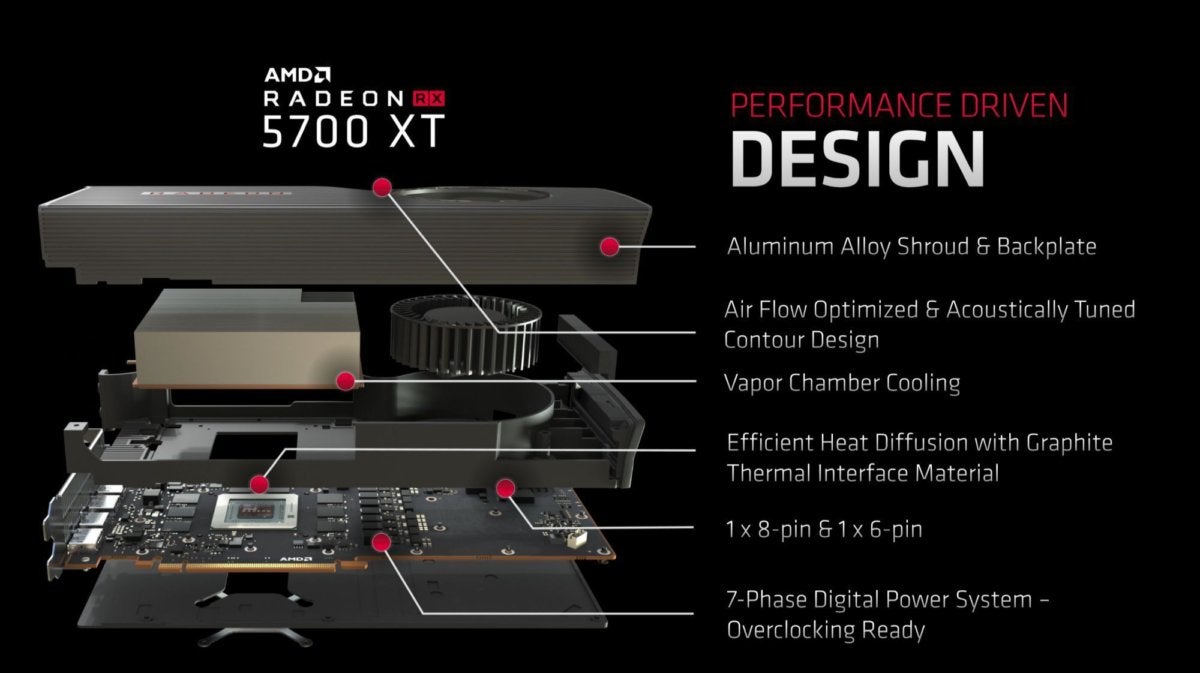 AMD
AMD Both the Radeon RX 5700 and RX 5700 XT return to blower-style cooler designs, even every bit Nvidia's Founders Variant cards reposition to dual-axial fans. Herkelman says IT was a sensitive conclusion: Blower-style coolers drum out hot air out of the lift of your system of rules, piece dual-axial fans dump it back into your rig, requiring your PC to have adequate airwave flow from case fans. Sticking to a cetacean-style design eliminates potential user error from the cooling system equation and provides a more universal baseline experience.
The decision makes sense on paper, simply anyone who suffered through a reference book Lope Felix de Vega Carpio 64 roaring hot fire next to them might glucinium grovelling right now. It was unpleasant. The new cooler isn't. Herkelman claims AMD invested a lot of time and feat into rising the Radeon RX 5700 series reference coolers, and those tweaks manifest in practice. These coolers still aren't quiet, but neither suffer they crossed the line in being noisy or distracting. While the reference Navi GPUs run at higher temperatures than Nvidia's competitor Founders Edition models, the fire u doesn't affect performance or usability. (Much along that in the benchmarking sections.)
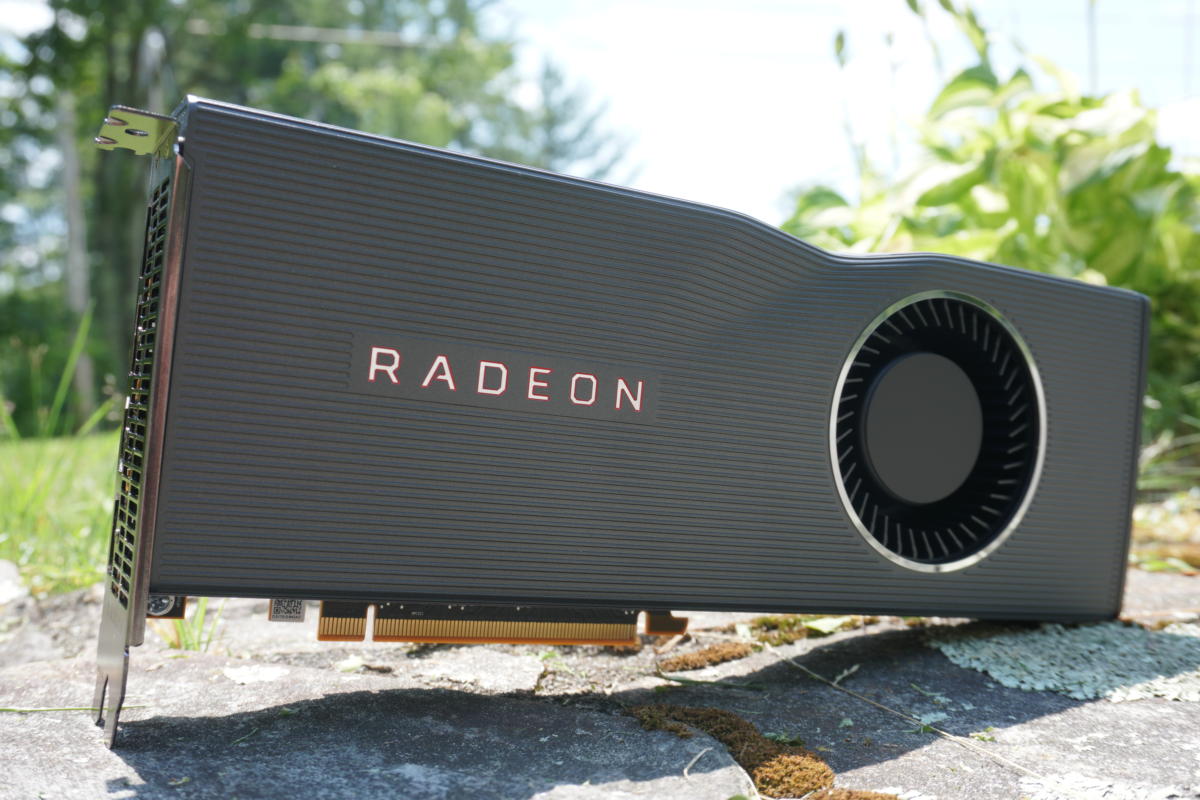 Brad Chacos/IDG
Brad Chacos/IDG The Radeon RX 5700 XT
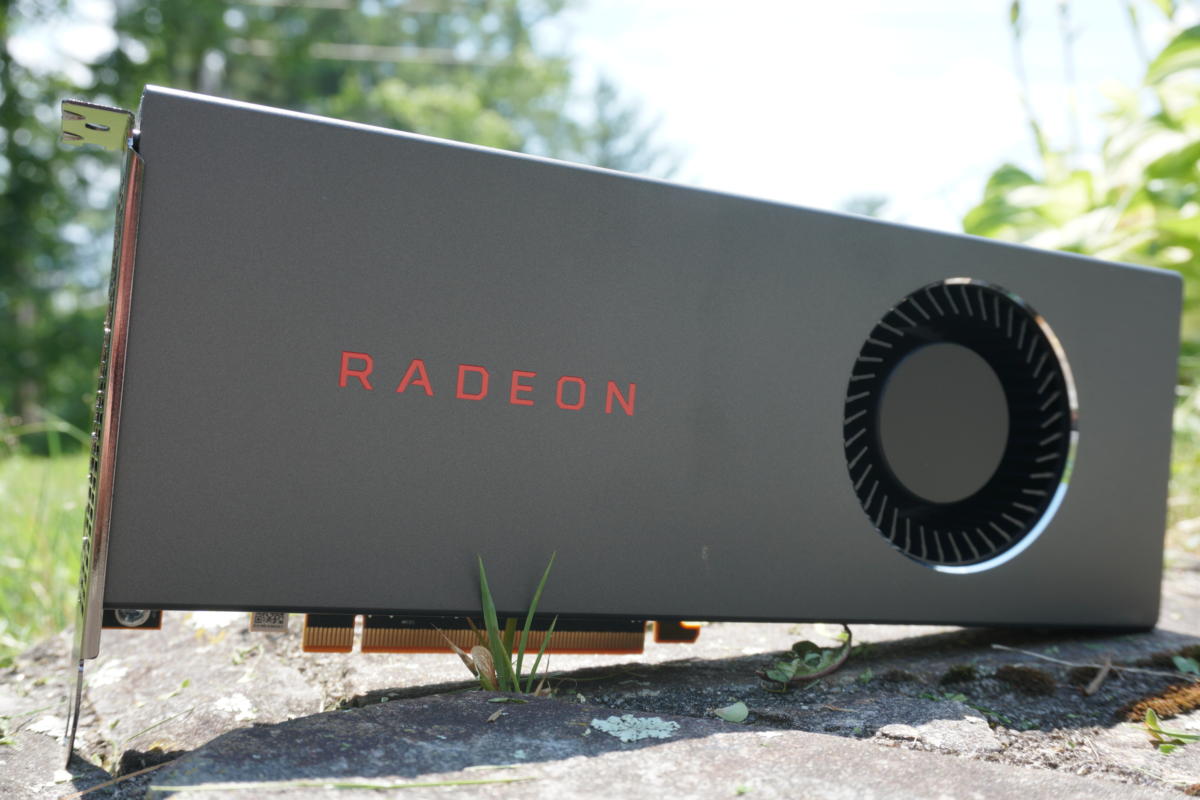 Brad Chacos/IDG
Brad Chacos/IDG The Radeon RX 5700
AMD's new GPUs feature various winding-sheet designs. The Radeon RX 5700 looks similar a sturdier, cleaner upgrade to the stark cerise-connected-black design ethos introduced with AMD's Radeon RX 400-series, piece the Radeon RX 5700 XT changes things up with a series of closely leaded lines that run the length of the black pall, and a red band that intersects with the lighted Radeon logo on the side of the card. It also packs an intriguing wave-like deformation on the edge of the card. IT'll probably prove divisive, simply I put on't mind it. Both cards require 6-pin and 8-trap king connectors, with the Radeon RX 5700 demanding 185 Isaac Watts of total room power and the Radeon RX 5700 XT needing 225W.
The Radeon RX 5700 XT ships with a backplate; the Radeon RX 5700 does non. The RX 5700 Crosstalk includes additive venting at the rear edge of the card, while the cheaper Navi GPU gets a solid back edge.
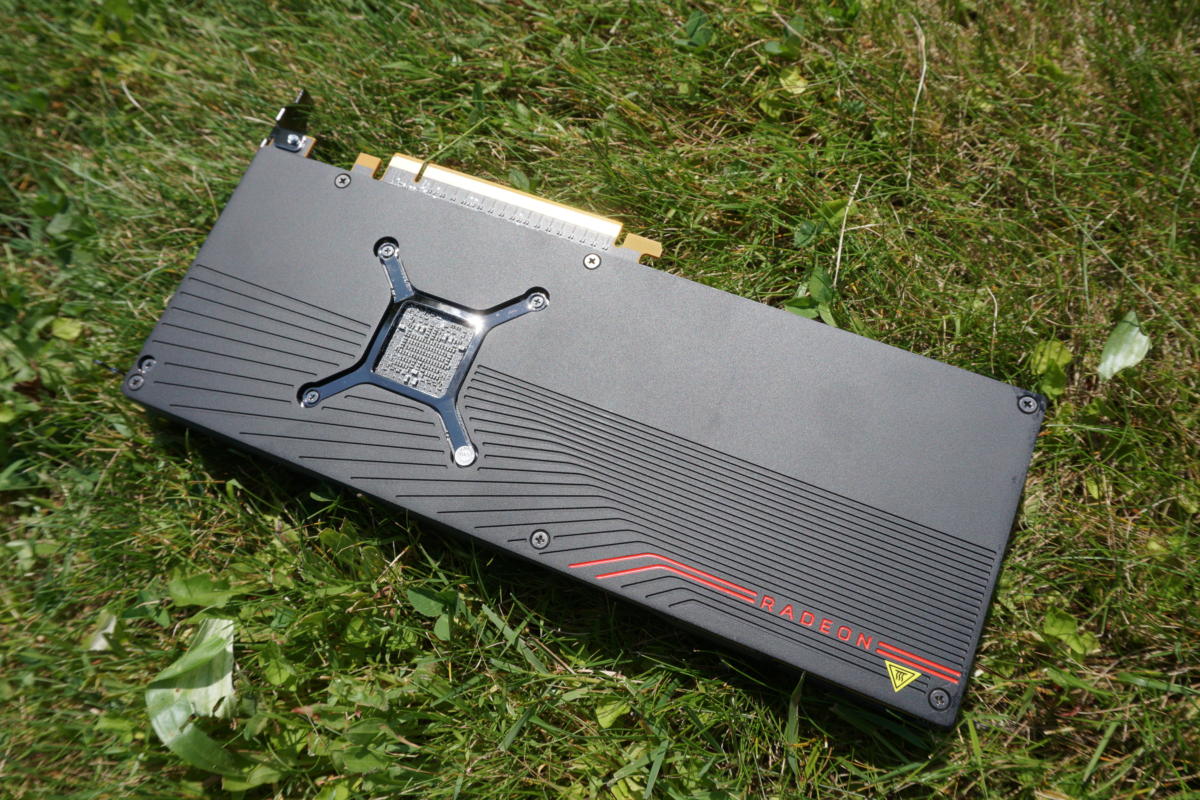 Brad Chacos/IDG
Brad Chacos/IDG The card game ship with an HDMI 2.0b larboard and a ternary of DisplayPort 1.4 connections. The DisplayPorts support Display Stream Compression 1.2a, which lets the GPU power fearsome monitors over a single cord, maxing out at 4K/240Hz, 4K HDR at 120Hz, and 8K HDR at 60Hz. More importantly, Showing Stream Compaction lets you run those high-velocity 4K HDR monitors without leaning on chroma subsampling, which rear affect the readability of fine text in some scenarios. Asus teased the "world's first Show Stream Compression monitor" at AMD's E3 event. With 4K, 144Hz speeds and HDR 1000 financial support, it appears collected to challenge Nvidia's vaunted G-Sync Crowning (previously G-Sync HDR) monitors, like the brilliant Acer Marauder X27.
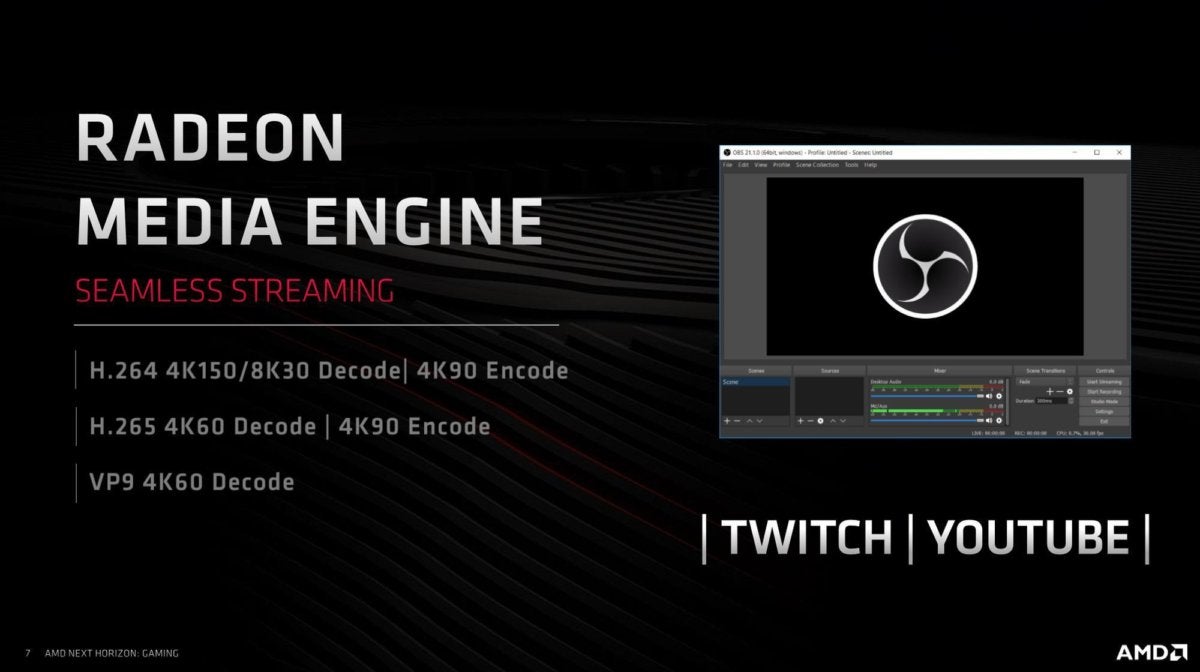 AMD
AMD Finally, the Radeon RX 5700 series introduces a new version of the Radeon Media Engine, with advisable computer hardware accelerated support for VP9 decoding, and some encoding and decryption with H.264 or H.265.
You'll notice two glaring omissions from this rundown of upgrades: support for shaft tracing and covariant rate picture element blending, both of which were introduced in Nvidia's GeForce RTX 20-series, and some of which were embraced (agnostically) past Windows 10's DirectX 12. You can hear Herkelman explain why AMD made the determination to neglect dedicated ray tracing hardware from the Radeon RX 5700 series at the 39:20 mark in the video interview near the spinning top of this article. Quick tl;dr: AMD will enable ray tracing when there are Thomas More games on tap that defend IT, and when the performance hit becomes to a lesser extent drastic. "Preceptor't puzzle out me evil: It is definitely the early," he says. "Merely it inevitably to glucinium done right."
That's it for the hardware side of things. But AMD's latest graphics cards bundle off some new software tricks, too.
Next page: Radeon Software improvements
Radeon Software improvements
AMD gave Radeon Software a huge overhaul in December, but information technology's adding some new features for the Radeon RX 5700 series release. Radeon Software Epinephrin 2019 Edition interpretation 19.7.1 (phew!) volition go live Lord's Day alongside the new hardware. While time constraints prevented us from giving these fresh goodies a test force back ahead of this review, they're worth highlight.
Radeon Anti-Lag
Radeon Anti-Lag was created to make esports gamers more aggressive by, swell, reduction stimulus lag when you click your mouse. In GPU-half-bound scenarios (like esports), AMD says the CPU registers clicks at least one frame ahead of the GPU, and the GPU then renders the response on-screen, resulting in a delay of at to the lowest degree two frames, surgery 33.3 milliseconds at 60 fps. "Radeon Anti-Lag dynamically improves the pacing of the CPU work, allowing the CPU work to lap a significant portion of the GPU work, and so the CPU doesn't get overly far in front of the GPU." That can bring the delay plump for down to a single frame, or 16.7 milliseconds at 60 Federal Protective Service, the company says.
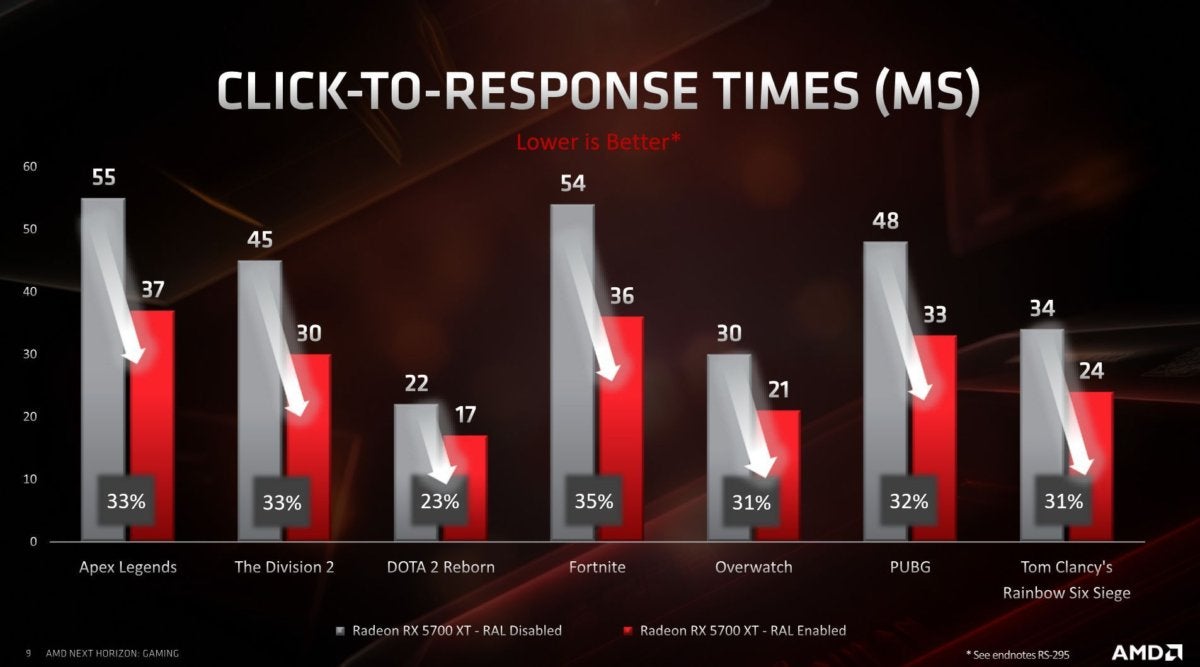 AMD
AMD Radeon Anti-Lag click-to-reception improvements, measured by AMD.
Not everyone can even out feel a single human body's deserving of improvement to input signal lag. But in the frantic, fast world of rivalrous esports, every second matters, especially in high-skilled frolic.
You can try tabu Radeon Anti-Lag past enabling IT for specific games in the Radeon Settings app's Gaming tab. You rear also turn it on in-game using the Radeon Overlay. Information technology works with all DirectX 11 games with any Radeon GPU, but the Radeon RX 5700 and 5700 XT can enable it for DX9 games, too. Don't enable it universally; AMD's reviewers guide warns that receivable to the manner it works, it has "a minor impingement" connected gaming frame rates. Information technology's worth using in esports games where you can feel the dispute in responsiveness, merely IT isn't recommended for other genres.
Radeon Image Sharpening
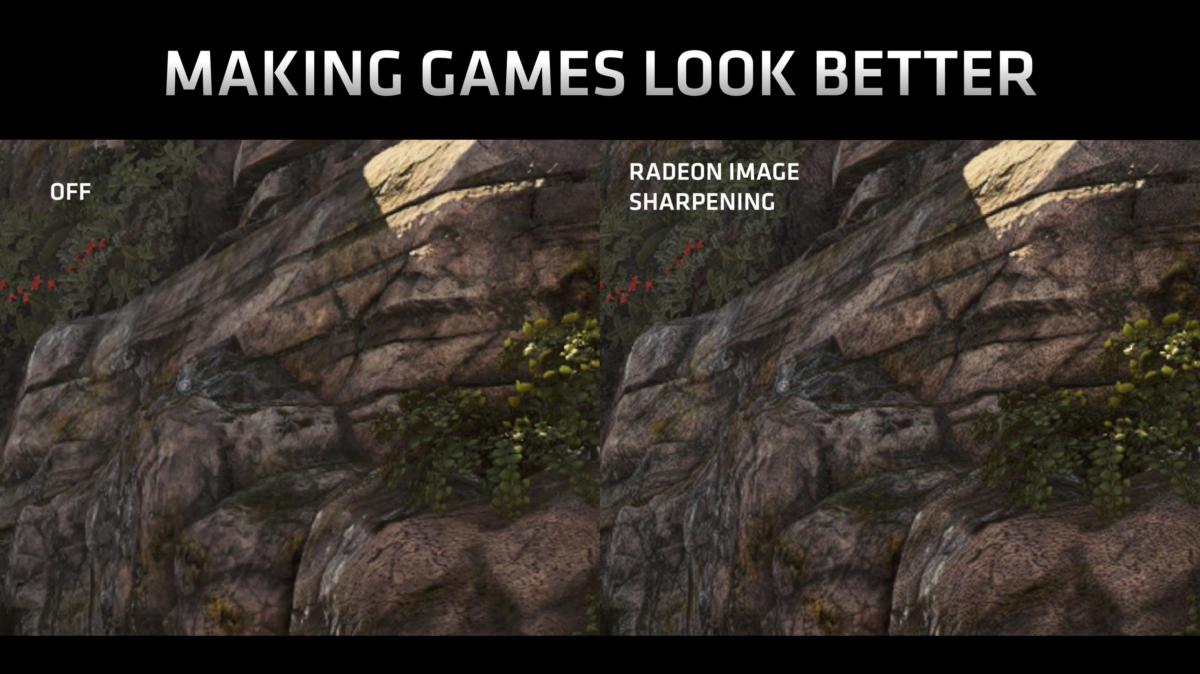 AMD
AMD You love the Sharpening filter in Nvidia's Ansel tool? Yeah, Radeon Image Sharpening is nothing like that. Piece Ansel applies a sharpening filter to the entire in-game image, Radeon Image Sharpening uses algorithms to intelligently sharpen only the areas that involve it, reducing the fuzziness that can pop up when you activate various anti-aliasing methods or run games at a lower solution than your display's maximum. Better yet, IT does so with next to nary carrying out impact, AMD says.
Hither's how AMD's reviewers guide describes Radeon Image Sharpening:
"Because RIS is supported an algorithm that modulates the grade of sharpening depending on dividing line, it clarifies interior object details while going away high-contrast edges largely untouched. RIS sidesteps unkind artifacts like "ringing" or halos that normally affect other sharpening methods. Interim, it avoids prejudicial smooth gradients on high-contrast edges. As a solvent, RIS can be combined with virtually any anti-aliasing technique used in a game, and the results volition look great.
"When paired with Radeon GPU scaling, RIS allows gamers to configure their games to run at lower resolutions to optimize performance while still enjoying crisp, detailed full-screen visuals."
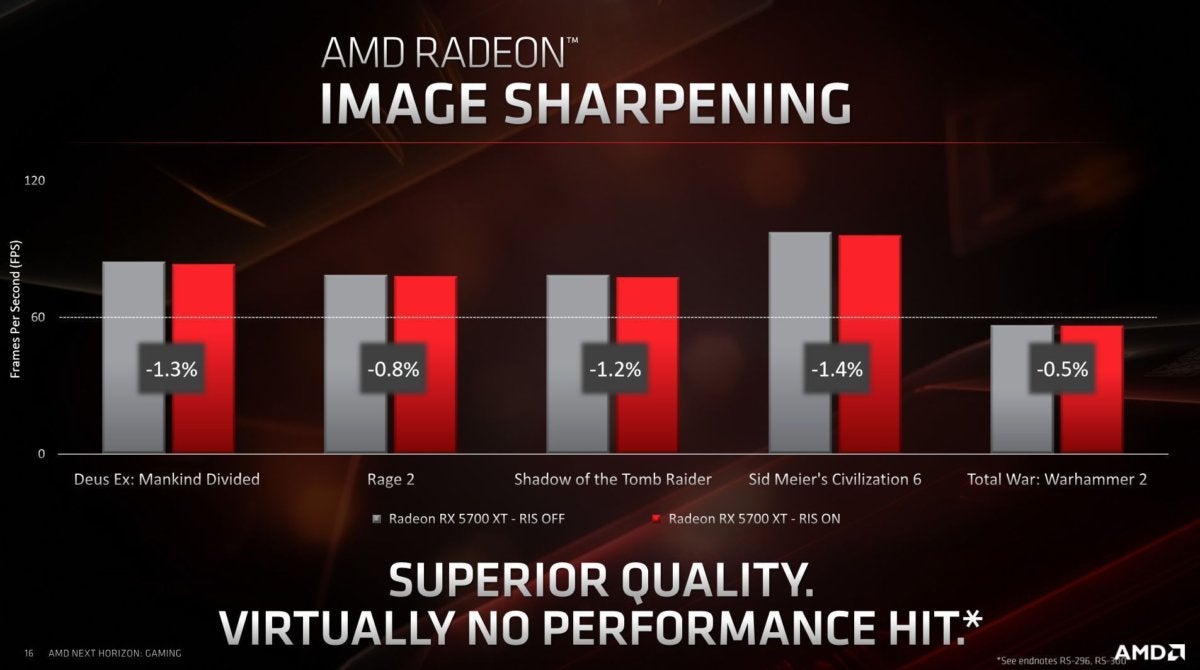 AMD
AMD Sounds slap-up! And speech Scott Herkelman on The Full Nerd, it sounds same Radeon Image Sharpening could be a cornerstone of AMD's future ray tracing ambitions.
For now, though, it works lone with DirectX9, DirectX12, and Vulkan games on the Radeon RX 5700 GPUs. Yes, DX11 support appears to be missing for now, and RIS can't outgrowth HDR visuals, either. To activate it, open the Radeon Settings app and enable Radeon Project Sharpening in the Show tab. AMD likewise recommends activating the GPU Scaling option in the Display tab if you're victimisation RIS to compensate for using a lower resolving power than your display's maximum.
Tweaks and tuning
While Radeon Image Sharpening and Radeon Anti-Lag steal the spot, AMD also added ministering tweaks to existent tools in Radeon Software Adrenalin 2019 Variant 19.7.1. We'll chop-chop recap the most notable.
Radeon Gelidity was already impressive, intelligently ramping down frame rates during static scenes to purpose less power—sometimes importantly and then—without making it feel like your game's running slower. And now it's eventide better. The latest Radeon Software update alters Chill so that it "automatically sets its frame plac targets based on the refresh capability of the connected display." Antecedently, Chill targeted 72-fps and 144-fps thresholds on every display. Now, the display-aware feature film will change that to 30 fps and 60 fps on 60Hz monitors "to meliorate correspond the rate of in-spirited animation to the display's update rate."
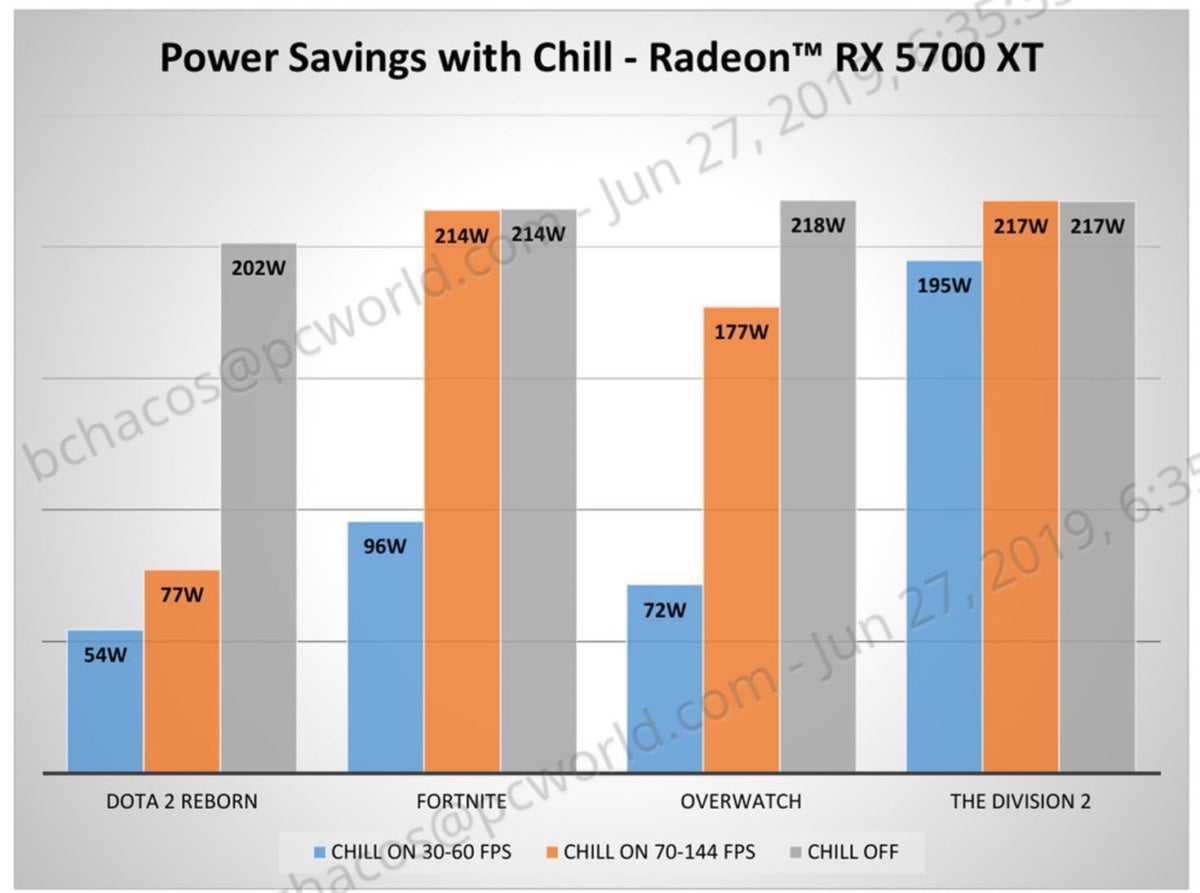 AMD
AMD The lower berth target thresholds can also tighten power demands even further. AMD's briefing materials claim that Chill can right away deliver in the lead to 2.5X more power savings than before, and like I aforementioned, it was already really great. I'm looking forward to examination this knocked out with a 60Hz video display.
The new software adds a Settings Snapshot pick that lets you make over, save, and encumbrance custom profiles. Radeon Wattman receives just about extra polish, too, with a new great power meter and a summary of changes after you run one of its auto-overclocking Beaver State -undervolting tools. Now, you'll atomic number 4 notified of your new minimum and upper limit time speeds after the auto-tuning finishes.
Finally, if you wealthy person a gaming PC in your living room, a untried Self-activating Low Latency Mode feature lets your Radeon GPU force your TV into gaming style with no effort on your end (assuming your TV offers a lower reaction time gaming mode, natch).
Now that the stage is set, let's get to the games!
Next Page: Our quiz system, gaming benchmarks begin
Our test organization
Our dedicated artwork card test system is packed with some of the fastest complementary components available to put any potential operation bottlenecks squarely on the GPU. Most of the ironware was provided by the manufacturers, but we purchased the cooler and storage ourselves.
- Intel Nub i7-8700K processor ($350 happening Virago)
- EVGA CLC 240 closed-loop liquid cooler ($120 on Amazon)
- Asus Maximus X Hero motherboard ($395 on Amazon)
- 64GB HyperX Marauder RGB DDR4/2933 ($420 on Amazon)
- EVGA 1200W SuperNova P2 superpowe supply ($230 connected Amazon)
- Corsair Crystal 570X RGB case, with front and high panels separate and an redundant rear rooter installed for improved airflow ($130 on Amazon)
- 2x 500GB Samsung 860 EVO SSDs ($78 each on Virago)
We're comparing the $350 Radeon RX 5700 and $400 Radeon RX 5700 XT against Nvidia's newborn $399 GeForce RTX 2060 Extremely and $499 RTX 2070 Super Founders Edition cards, of course. We've too included results from the Founders Variation models of Nvidia's original RTX 20-series card: The $350 RTX 2060, $600 RTX 2070, $800 RTX 2080, and $1,200 RTX 2080 Ti. Note that aside from the RTX 2060, all other non-Super Founders Edition cards come overclocked and more expensive than reference work models for each single GPU. We also tested AMD's parallel Radeon options: the $700 Radeon Septenary, $500 Vega 64, and $400 Vega 56.
All prices cited are launch MSRP. You can often happen these cards cheaper on the streets these days.
Each game is tested exploitation its in-game bench mark at the highest possible nontextual matter presets, with VSync, frame rate caps, and every GPU vendor-specific technologies—like AMD TressFX, Nvidia GameWorks options, and FreeSync/G-Sync—disabled, and temporal opposed-aliasing (TAA) enabled to push these high-goal cards to their limits. If anything differs from that, we'll refer it. We run each benchmark at least three times and list the average result for each tryout.
We've added a couple of new games to our testing suite (Partition 2, Far Cry: Inexperienced Dawn) and far a handful of others (Rainbow Sixer Siege, Far Cry 5, Ashes of the Singularity: Escalation, Middle-earth: Shadow of Warfare). We're hoping to add u Metro Exodus to the mix in future reviews but were unable to do sol for this one referable severe time constraints.
Gaming execution benchmarks
Partition 2
Let's start with the latest games. The Division 2 is one of the trump looter-shooters ever created, and the luscious visuals generated by Ubisoft's Snowdrop engine make it even easier to get lost in post-prophetic Washington D.C. The integral benchmark cycles through four "zones" to test an array of environments, and we test with the DirectX 12 renderer enabled. It provides better performance crosswise the board than the DX11 renderer, but requires Windows 10.
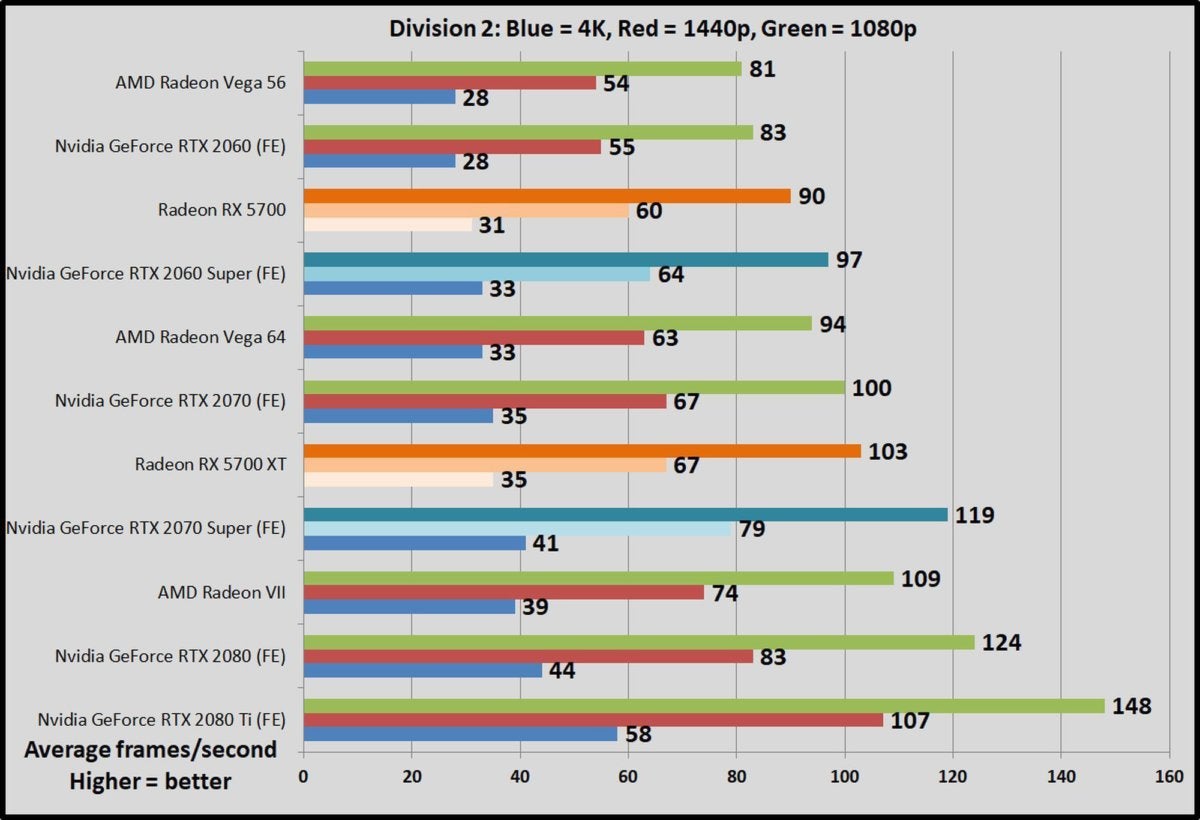 Brad Chacos/IDG
Brad Chacos/IDG The Radeon RX 5700 trounces the originative GeForce RTX 2060, while the Radeon RX 5700 XT surpasses the equally priced RTX 2060 Large and equals the original RTX 2070 in carrying into action. The GeForce RTX 2070 Tops is the fastest new carte du jour of the wad, but it costs importantly more than AMD's Navi brace aft their pre-launch price drops.
Remote Cry: New Dawn
Another Ubisoft style, Far Cry: New Dawn drags Farthest Cry 5's wonderful gameplay into a post-apocalyptic hereafter of its own, though this vision is a lot more bombastic—and pink—than The Division 2's bleak setting. The game runs connected the latest version of the long-functional Dunia engine, and it's slightly more strenuous than Far Cry 5's built-in bench mark.
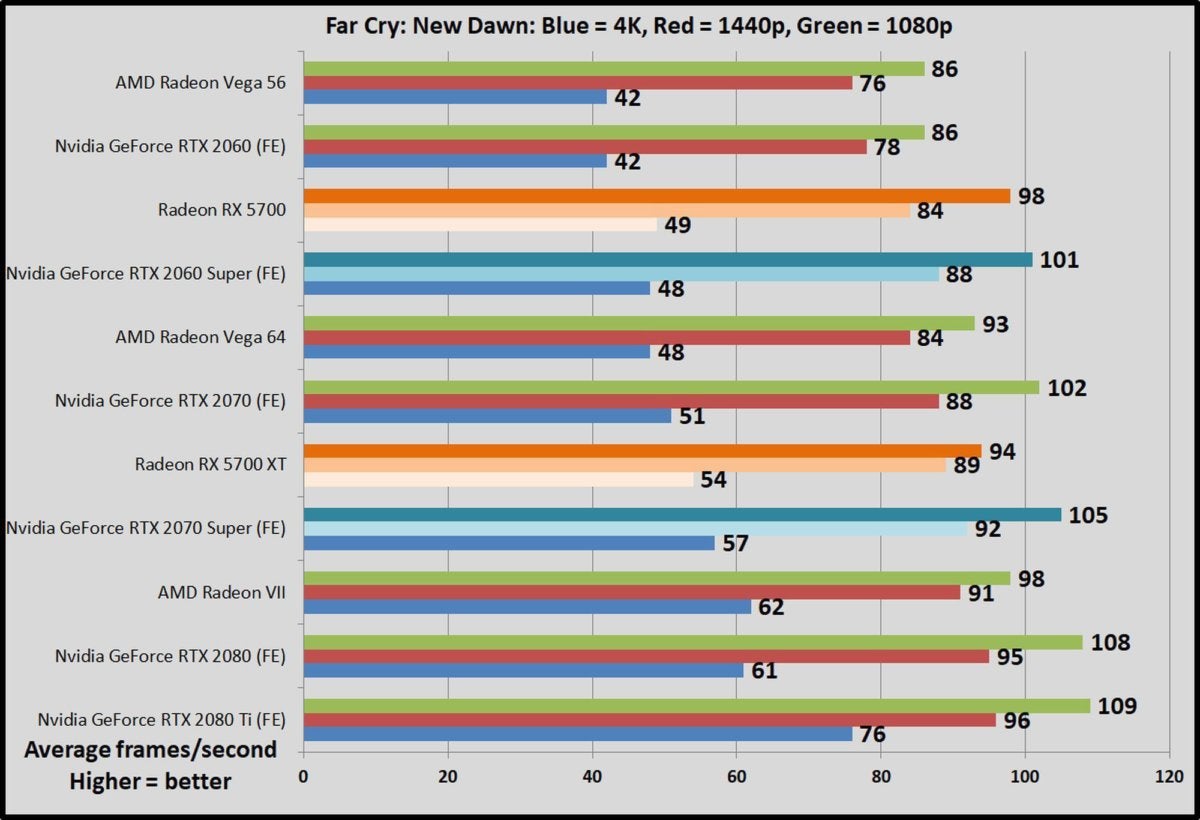 Brad Chacos/IDG
Brad Chacos/IDG The Radeon RX 5700 wallops the RTX 2060 Founders Edition for the same price, piece the Radeon RX 5700 XT delivers performance on par with its competitor. (Observe: There was an error transcribing the results into Excel here. The 1080p performance for the Radeon RX 5700 series were swapped around; the Radeon RX 5700 should read 94fps, and the Radeon RX XT 98fps.)
Adjacent varlet: Play benchmarks continue
Strange Brigade
Strange Brigade ($50 on Humble) is a cooperative third-person shooter where a team of adventurers blasts done hordes of mythological enemies. It's a technological showcase, built around the next-gen Vulkan and DirectX 12 technologies and infused with features ilk HDR support and the power to toggle asynchronous compute off and on. It uses Uprising's custom Azure locomotive. We examine the DX12 renderer with async reckon unsatisfactory.
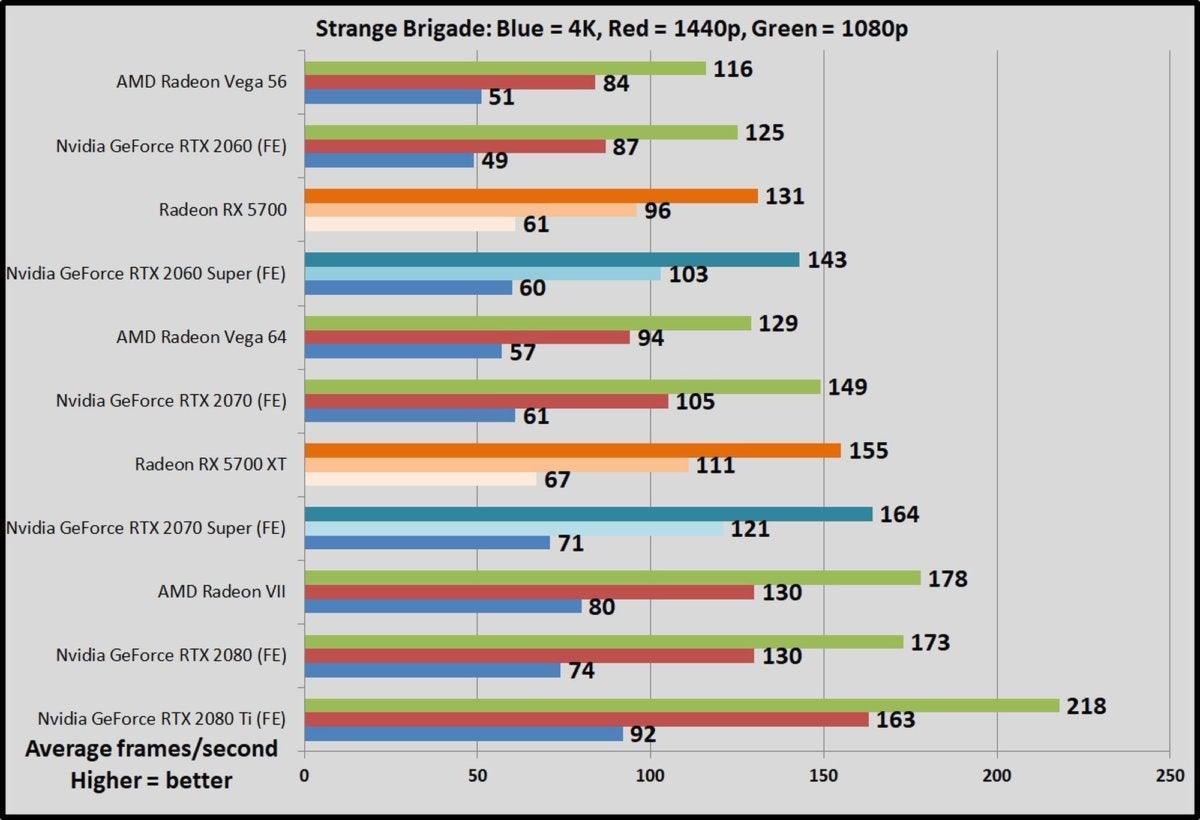 Brad Chacos/IDG
Brad Chacos/IDG Strange Brigade tends to do very well connected AMD hardware, and the Radeon RX 5700 series beats down the similarly priced RTX 2060 and 2060 Superintendent. If AMD perplexed to its newfangled pricing, information technology wouldn't throw familiar the 2060 and 2070 Super duo. Cutting the price was a smart move.
Shadow of the Tomb Despoiler
Darkness of the Tomb Raider ($60 on Humble) concludes the boot trilogy, and information technology's utterlygorgeous. Transparent Enix optimized this game for DX12, and recommends DX11 only if you're using older hardware or Windows 7, soh we test therewith.Dwarf of the Grave Raider uses an enhanced version of the Foundation locomotive engine that too poweredRise of the Tomb Raider.
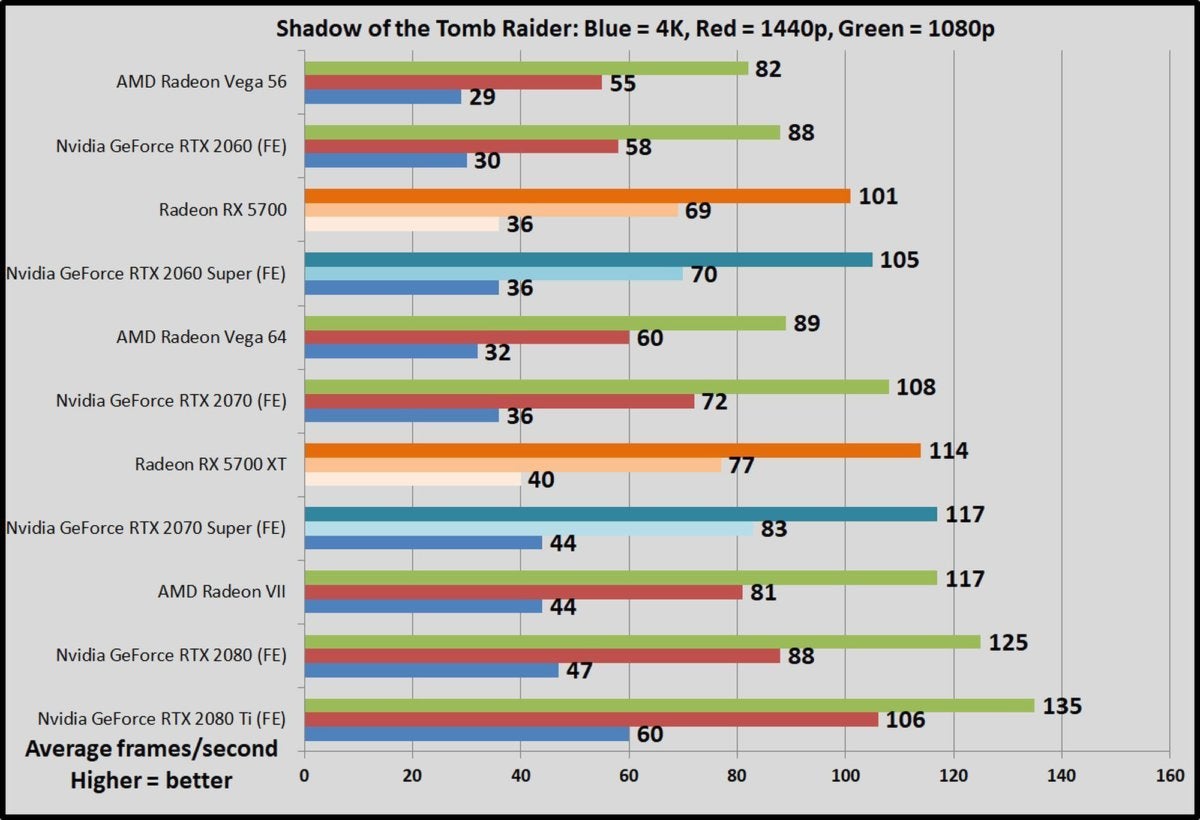 Brad Chacos/IDG
Brad Chacos/IDG In real time Hera's an stimulating result. Shadow of the Tomb Raider normally favors Nvidia architectures, just AMD's RDNA has apparently closed in the col. The Radeon RX 5700 is neck-and-neck with the RTX 2060 Super here! And the Radeon RX 5700 XT is well in front of information technology.
Specter Recon Wildlands
Go up complete,Crysis. If you crank all the graphics options up to 11, like we do for these tests,Ghost Recon Wildlands($50 on Humble) and its AnvilNext 2.0 engine absolutelymeld GPUs, even with a sequel due afterward this year. It's by far the most straining game in our cortege, even with newer stunners like Division 2 in the mix.
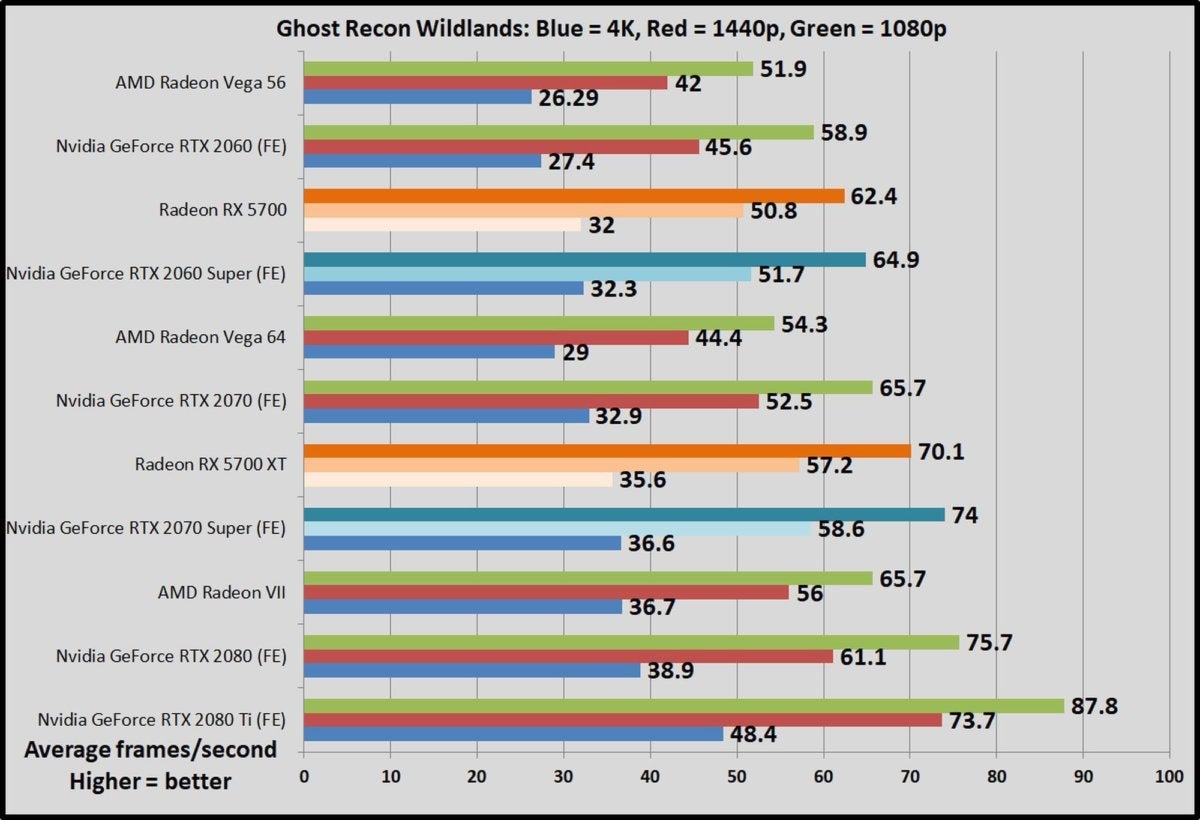 Brad Chacos/IDG
Brad Chacos/IDG Ghost Recon Wildlandsalso prefers Nvidia's GPU architecture generally—or at least IT used to. The overhauled RDNA computer architecture definitely shook something up, leveling the playacting airfield in games that preferred GeForce GPUs in prior generations. The Radeon RX 5700 duet manages to force effectively even with both Super card game here—likewise as the uttermost pricier $700 Radeon VII.
F1 2018
The latest in a long line of successful games,F1 2018($60 connected Humble) is a precious stone to test, supplying a wide array of both graphical and benchmarking options—making information technology a much more reliable (and fun) option that theForzaseries. IT's built on the fourth version of Codemasters' buttery-smooth Ego biz engine. We prove two laps on the Australia course, with clear skies.
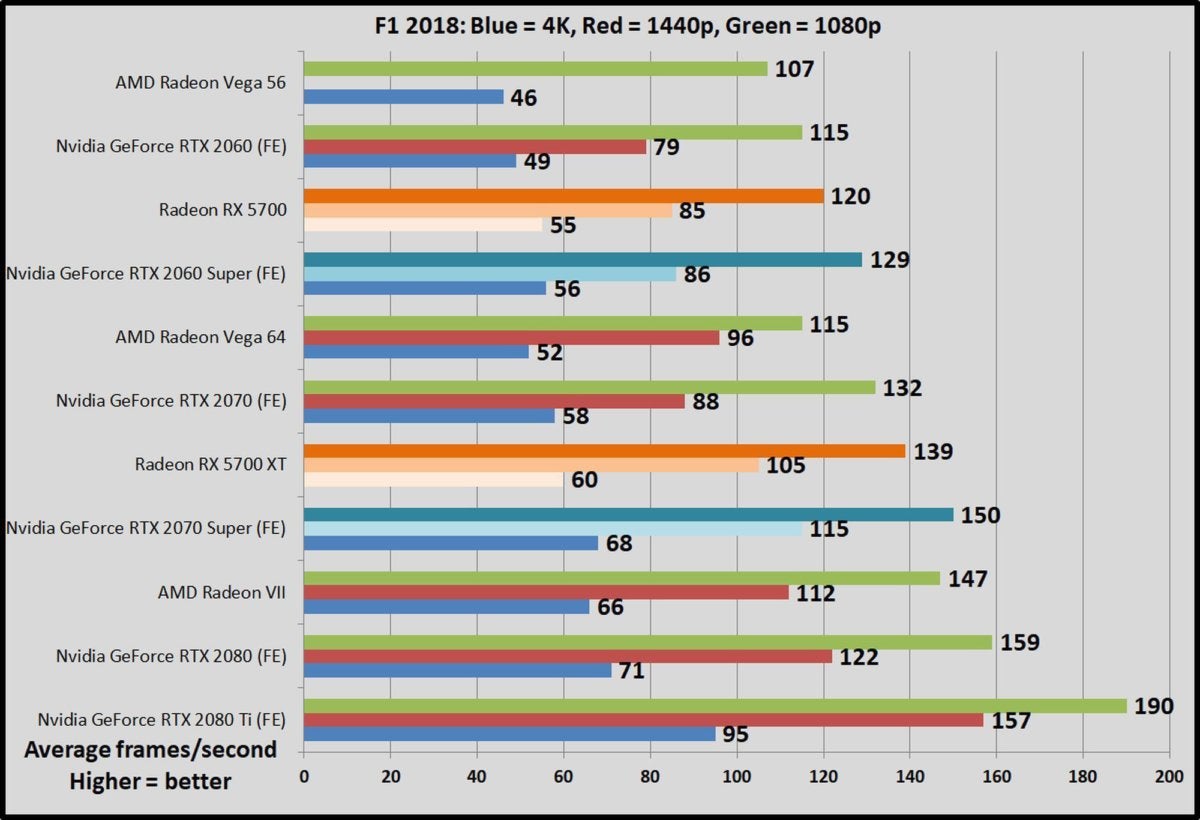 Brad Chacos/IDG
Brad Chacos/IDG Nvidia's RTX Superintendent GPUs blow well past the Radeon RX 5700 phratr here, especially at the more popular 1440p and 1080p resolutions. But again, AMD's price cutting off changes the melody, with the $350 Radeon RX 5700 surpassing the $350 RTX 2060 in performance, and the $400 Radeon RX 5700 Crosstalk blowing well early the $400 RTX 2060 Crack at 1080p and 1440p resolutions.
GTA V
We're going to wrap things up with a crippled that ISN't really a optical barn-burner, but still tops the Steam clean charts day in and day retired. We examGrand Larceny Motorcar V ($30 on Humble) with all options turned to Same High, wholly Advanced Graphics options leave off extended shadows enabled, and FXAA.GTA Vruns along the RAGE engine and has received substantial updates since its first launch.
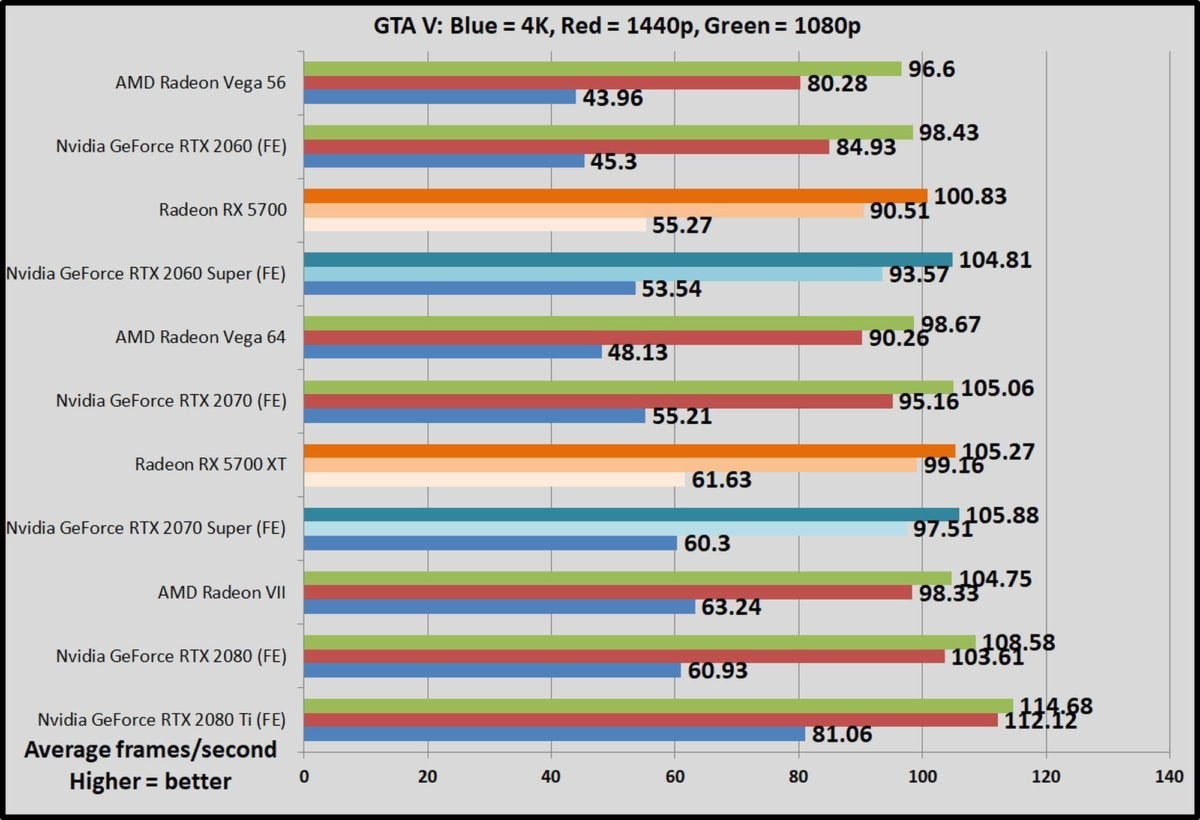 Brad Chacos/IDG
Brad Chacos/IDG Third time's a trend. GTA V has performed better along GeForce computer hardware ever since it launched years and years agone, simply now, the Radeon RX 5700 and 5700 XT draw even with Nvidia's pricier RTX Ace options. The vastly more big-ticket Radeon Heptad is still a loser here.
Next page: Power, thermals, and noise
Force draw, thermals, and noise
We likewise tested the Radeon RX 5700 and RX 5700 XT using 3DMark's highly respected Fire Strike synthetic benchmark. Flack Strike runs at 1080p, Fire Strike Extreme runs at 1440p, and Fire Discove Ultra runs at 4K resolution. All fork over the same conniption, but with more intense graphic effects as you rise up the scale, so that Extreme and Ultra flavors stress GPUs regular more. We record the graphics score to eliminate variance from the CPU.
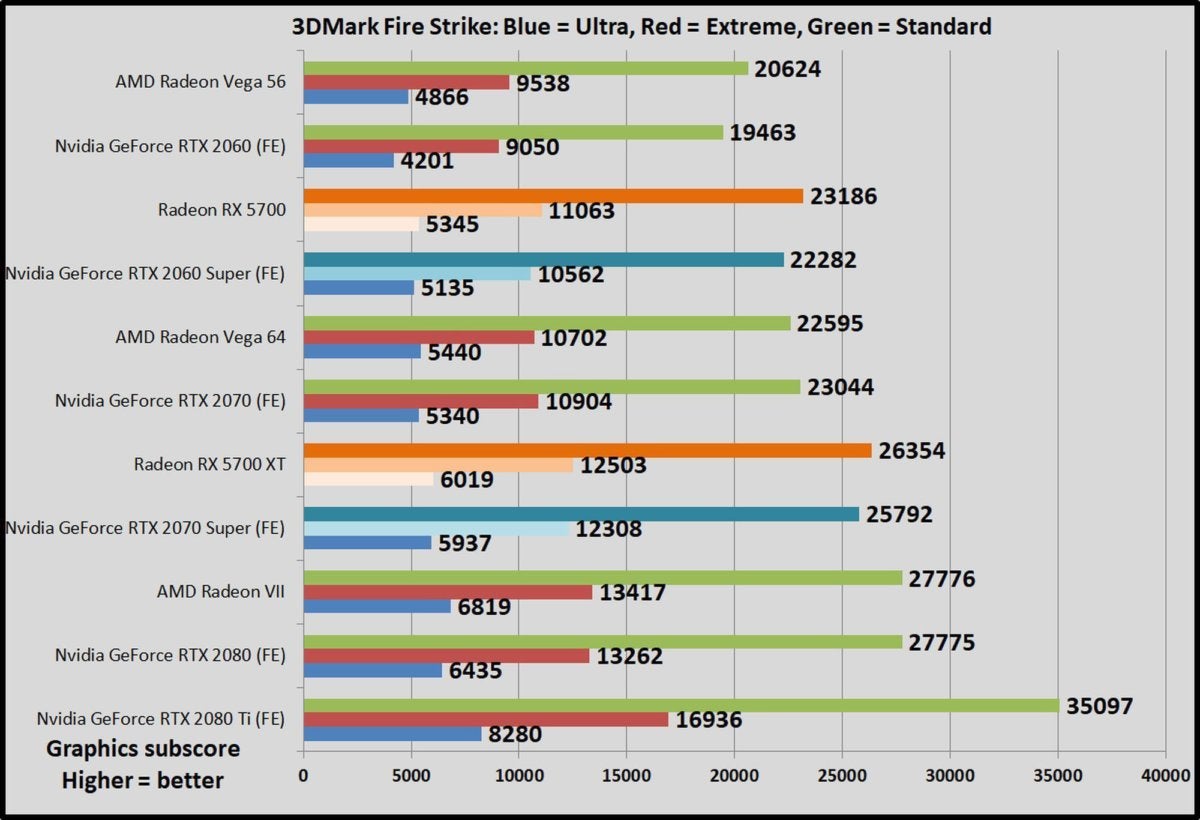 Brad Chacos/IDG
Brad Chacos/IDG The Radeon RX 5700 GPUs attain higher scores than the RTX Super duo, even though Nvidia's cards achieved better results in most existent-world gaming tests.
We mental testing thermals by leaving HWInfo's sensor monitoring tool open during theF1 2018 five-swish power draw exam, noting the highest uttermost temperature at the end. AMD's new GPUs weren't recognized by HWInfo yet, so we used the company's Wattman monitoring tool to bar temperatures in the Radeon RX 5700 series.
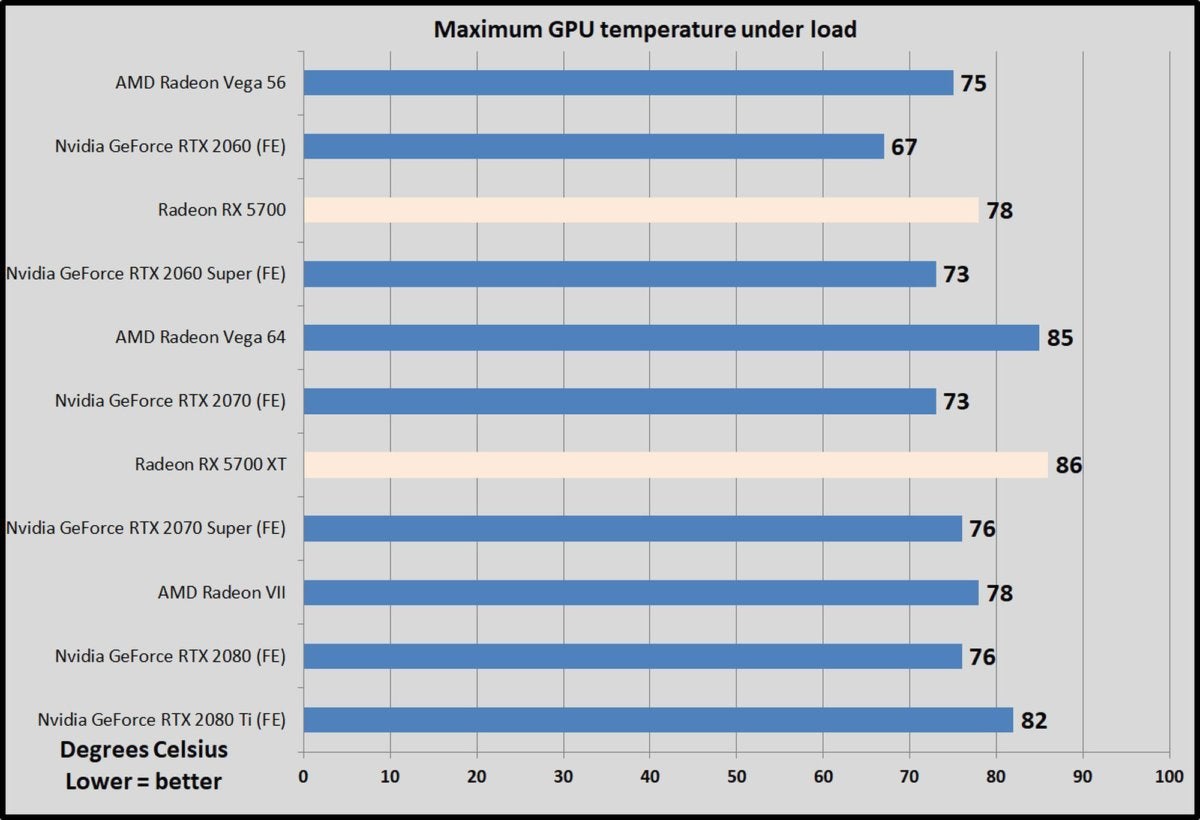 Brad Chacos/IDG
Brad Chacos/IDG The blower-elan cooler can't keep temperatures as low as Nvidia's three-fold-axial design, just information technology still gets the job finished. Most importantly, and unlike the Vega 64 reference book design, the Radeon RX 5700 GPUs aren't unpleasant to be around. They're a big advance.
We test power draw by looping theF1 2018 benchmark for about 20 minutes after we've benchmarked everything else, and noting the highest reading on our Isaac Watts Up Affirmative meter. The initial part of the race, where all competitive cars are onscreen simultaneously, tends to be the most demanding portion.
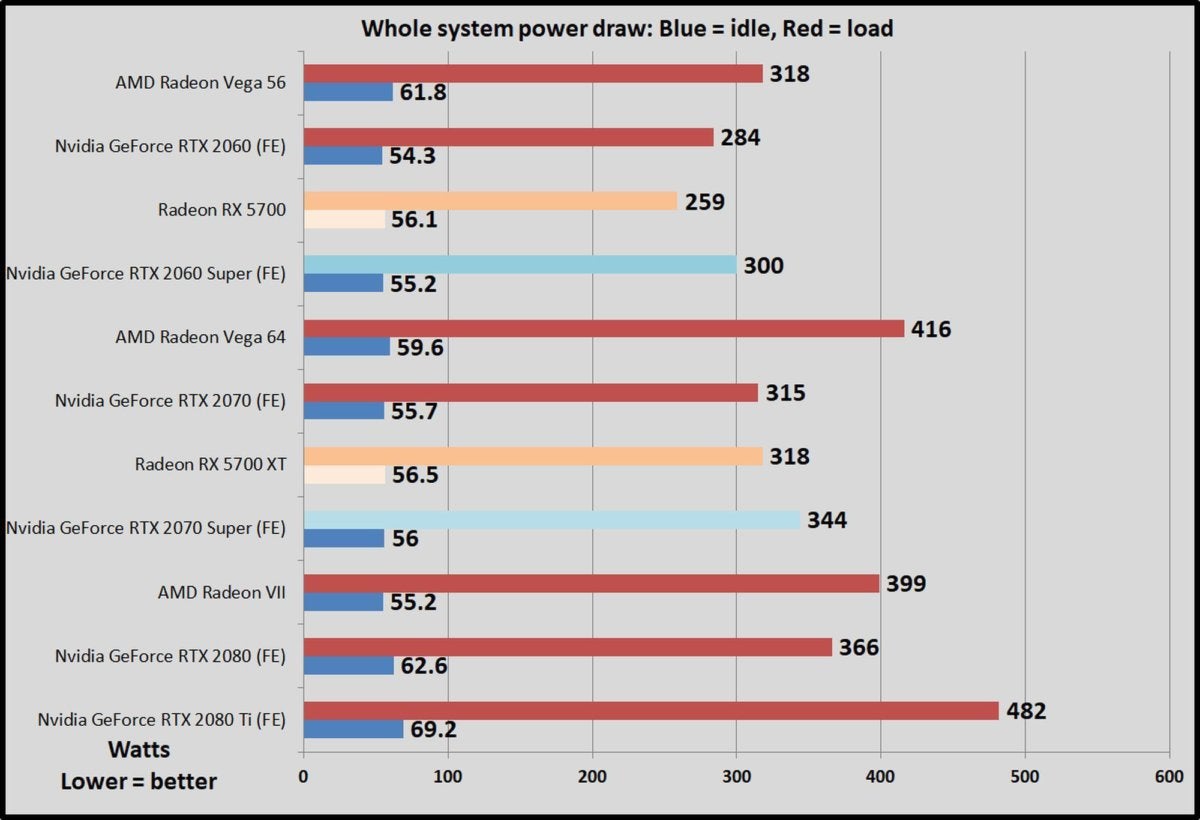 Brad Chacos/IDG
Brad Chacos/IDG Holy. Crap. Now this is unexpected! Ever since Nvidia discovered its Maxwell GPU architecture with the GeForce GTX 750 and 750 Ti all the way back in 2014, GeForce card game bear utterly pummeled their Radeon rivals. With AMD's new RDNA graphics architecture and the leap to the 7nm unconscious process, the domination is over.
Pay off attention to the Radeon RX 5700 versus the original not-Super RTX 2060, and the Radeon RX 5700 XT against the original RTX 2070. The Radeon GPUs were faster than those Nvidia GPUs in our gaming benchmarks, simply the Radeon RX 5700 uses significantly less power than the RTX 2060, while the RX 5700 XT draws even with the RTX 2070.
The days of laughing at Radeon power efficiency (or lack thereof) are over. This is rattling encouraging for AMD's future GPU development…though it remains to be seen what Nvidia's architects are capable of when Team Green shifts to 7nm at some point in the futurity.
Following page: Should you buy the Radeon RX 5700 series?
Should you buy the Radeon RX 5700 and 5700 XT?
A week ago, the answer would have been a clear yes. The Radeon RX 5700 and RX 5700 XT deliver more than enough dynamism to topple the original GeForce RTX 2060 and 2070. A hardly a days ago, the resolve would hold been more nuanced, since the Radeon tandem but rear end't quite match the firepower of the new RTX Super art cards. But in the wake of AMD's pre-launch price cuts, clarity returns.
Yes. Yes, you should buy these graphics cards.
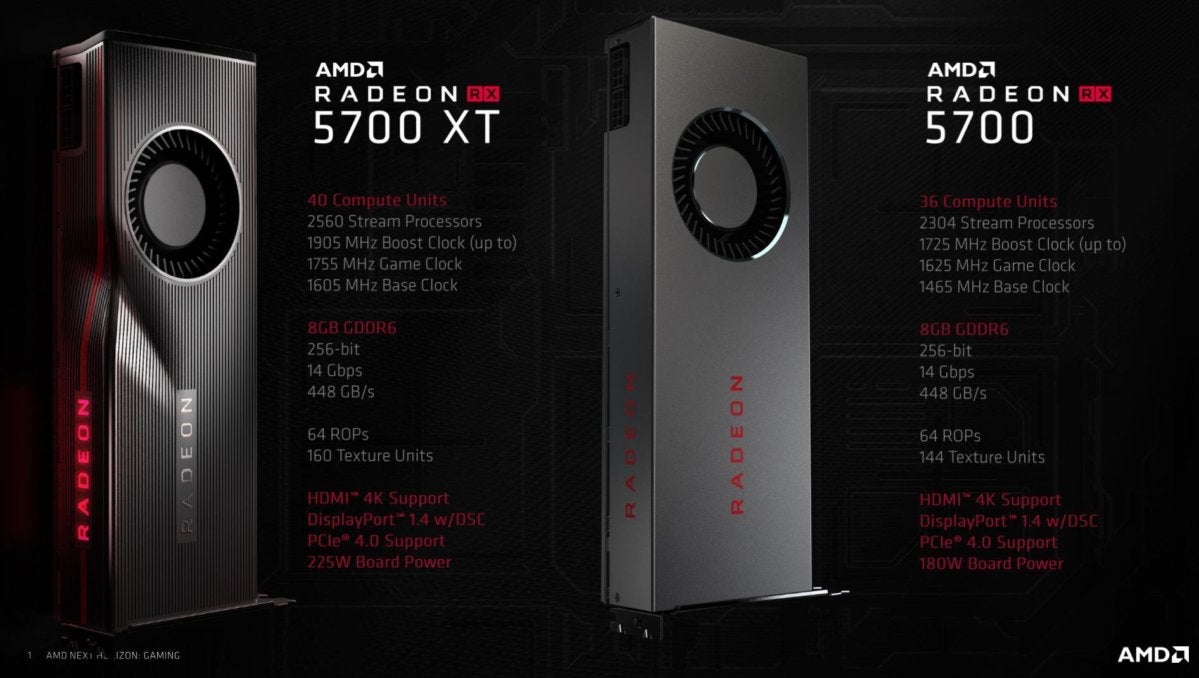 AMD
AMD The Radeon RX 5700 and 5700 Crosstalk are excellent, delivering noticeably better performance than the GeForce RTX 2060 and RTX 2060 Ace they're monetary value-matched with. The Radeon RX 5700 XT even manages to trade blows with the GeForce RTX 2070 Super in some games scorn costing $100 less. AMD just served up a delectable 1440p gambling twain.
These Navi GPUs would also stand out at high review rate 1080p gaming, and with the Radeon RX 5700 XT you can dabble with 4K gaming in some games if you put on't mind dialing some visual settings back from Ultra. If you're into content creation to a fault, poke around for reviews that impart how much of a difference the Radeon RX 5700's PCIe 4.0 connection makes in your workloads of choice.
The Radeon RX 5700 and RX 5700 Crosstalk are the first mainstream 7nm GPUs; the first PCIe 4.0 GPUs; and the first GPUs with DisplayPort Display Watercourse Compression for next-gen monitors. And as the number 1 7nm GPUs built using AMD's unused RDNA nontextual matter architecture, the Radeon RX 5700 series managed to surpass Nvidia's vaunted power efficiency and draw even with GeForce in games that previously favored Nvidia. That's a big freakin' deal. AMD even managed to fix its horrible reference ice chest!
The Radeon team accept a good deal to Be self-important of here. We can't wait to see what AMD does with RDNA next.
The one trick the new Radeon GPUs don't do? Period of time irradiate tracing, which currently requires dedicated hardware to achieve acceptable gaming frame rates. Only Nvidia's RTX GPUs offer that. But patc ray tracing is gaining traction, it's still in its infancy, with the cutting-butt on lighting features sole available in a fistful of playable games at the consequence. Given that; the Radeon RX 5700 oblation a far superior memory shape to the 6GB RTX 2060; and both AMD GPUs outpunching their RTX 2060 counterparts by significant margins, it's al dente to advocate the GeForce offerings over AMD's 7nm tandem.
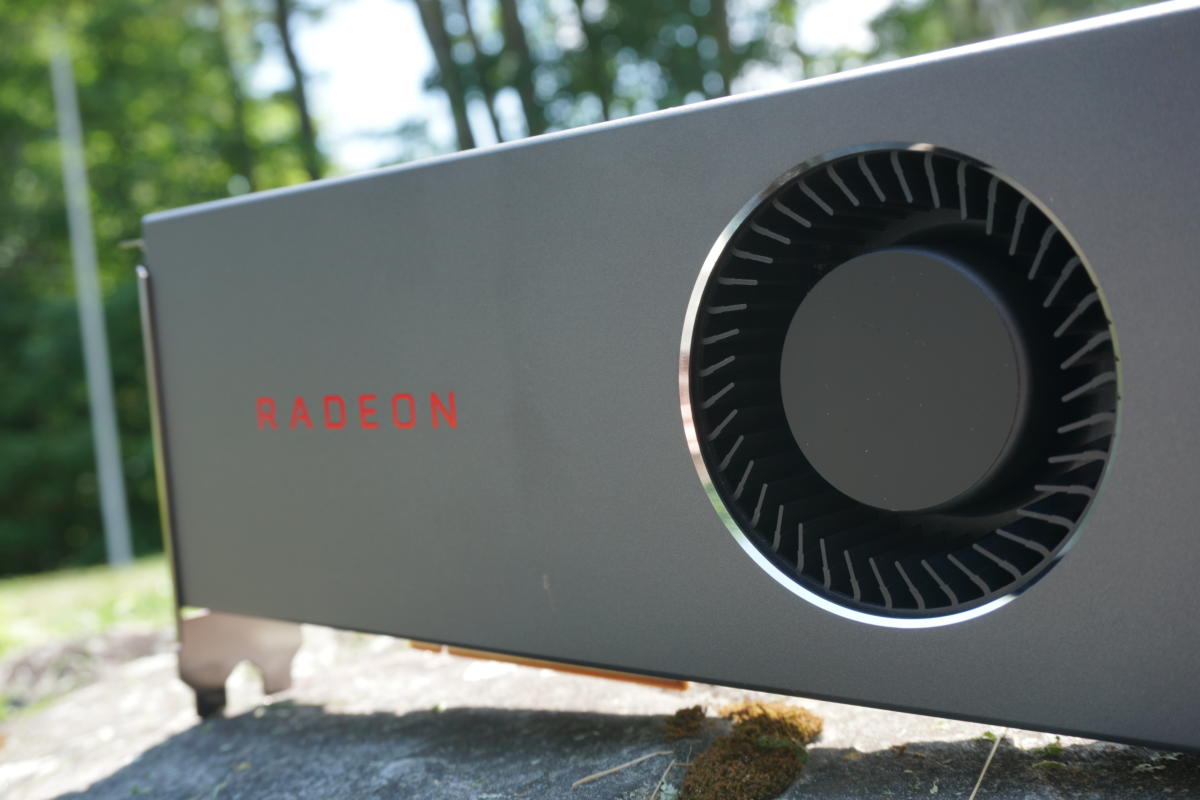 Brad Chacos/IDG
Brad Chacos/IDG If you can't refuse the femme fatale song of historical-time ray of light tracing, though, the GeForce RTX 2060 Large would follow the ameliorate option. The $500 GeForce RTX 2070 Super packs ray trace capabilitiesand sometimes beat generation the Radeon RX 5700 XT's carrying into action by a lot—but sometimes they're neck-and-neck, too. The RTX 2070 Super costs $100 more.
The Radeon RX 5700 and Radeon RX 5700 XT are truly big art cards that point to a bright in store for AMD. The surprise RTX Super reveal almost spoiled things, but aggressive pre-launch price cuts by AMD countered Nvidia's maneuvering. The Radeon RX 5700 and 5700 XT can't beat the RTX 2060 Super and 2070 First-rate, respectively, but AMD's duo trounces the RTX 2060 and 2060 Super they now contend directly against. Both cards realise high marks, and we're awarding the Radeon RX 5700 an Editors' Choice award.
It's sure been a whirlwind a couple of weeks for high-end nontextual matter cards, just now that the junk has lastly settled, gamers are getting markedly higher frame rates for their dollars. Yay contention!
Editor's note: For ii hours after initial publication, some Radeon RX 5700 art cards were scored 0.5-stars high than intended. We apologize for the error.
Promissory note: When you purchase something after clicking links in our articles, we may earn a runty commission. Record our affiliate link policy for more details.
Source: https://www.pcworld.com/article/397721/amd-radeon-rx-5700-and-5700-xt-review.html
Posted by: donahuewholoney.blogspot.com


0 Response to "AMD Radeon RX 5700 and 5700 XT review: Blazing new trails - donahuewholoney"
Post a Comment